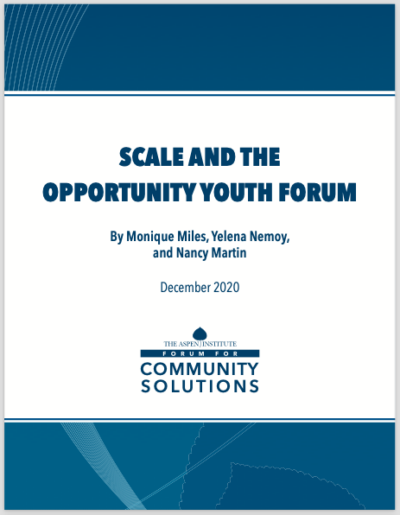
From the inception of the Opportunity Youth Forum, member communities have worked both to improve programming for current opportunity youth and to make the systemic changes necessary to expand their efforts to scale. The OYF continues to support communities to design and implement education and career pathways to create sustainable change that it hopes will, ultimately, support improved outcomes of a progressively larger proportion of opportunity youth. OYF network members are pursuing scale in a variety of ways, and this influences the strategies they use to expand their impact.
This report describes a range of strategies OYF communities are using to bring their efforts to scale, as part of an overarching focus on equity and ensuring equitable outcomes for all youth, including:
- Moving to Scale by Increasing Enrollment and Partners: OYF collaboratives are seeking to increase their reach to a greater proportion of the opportunity youth population, including to more geographic areas and to more partners in their communities.
- Moving to Scale by Proving and Expanding Promising Practices: OYF collaboratives are using pilots and supporting innovation to test or demonstrate the efficacy of promising programs and practices. Having identified effective programs and practices, they are seeking to expand these to scale in their communities.
- Moving to Scale by Expanding Pathways: OYF collaboratives are seeking to increase the number and types of programmatic opportunities available to meet the actual interests of youth and young adults.
- Moving to Scale by Changing Systems: OYF collaboratives seek systems change to improve outcomes for opportunity youth.
This report also includes discussion of the particular challenges and successes of efforts to bring opportunity youth work to scale in rural communities (home to 20% of opportunity youth in the US). While rural collaboratives reach smaller numbers of opportunity youth than do their urban and suburban counterparts, they often are reaching a much larger proportion of the opportunity youth in their communities.
And although collaboratives in rural areas often must make up for a lack of infrastructure, with fewer system partners and smaller bureaucracies, closer geographic proximity of partners and fewer bureaucratic barriers often provide opportunities for being flexible, nimble, and innovative in aligning partners, resources, and programs. By almost any measure of scale, aside from total number of youth served, rural OYF collaboratives are making significant progress toward bringing opportunity youth programs and policies to scale in their communities.